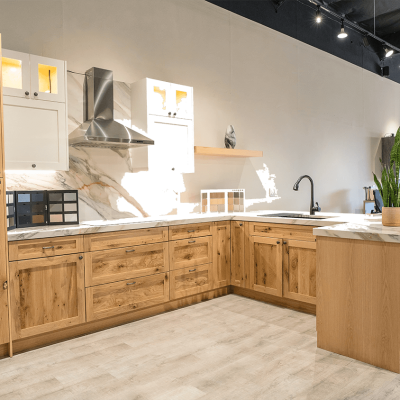Your kitchen cabinets are more than just storage; they are the heart of your kitchen, helping create a functional and stylish space. However, water damage is one of the leading causes of cabinet wear and tear. Kitchen cabinet water damage can lead to discoloration, warping, mold growth and other long-term problems that require costly repairs. With proper care and regular maintenance, you can prevent water damage and keep your kitchen cabinets looking new for years.
In this article, we’ll share simple maintenance tips and strategies to help you prevent water damage on your kitchen cabinets, whether you have traditional wood, moisture-resistant kitchen cabinets, or waterproof cabinet options.
What is Water Damage in Kitchen Cabinets?
Water damage refers to the harm caused when moisture or leaks affect your kitchen cabinets, leading to issues like swelling, warping, discoloration, or mold growth. It commonly happens due to plumbing leaks, spills, high humidity, or poor ventilation. If not addressed quickly, water damage can weaken the cabinet structure and require costly repairs or replacements.
1. Invest in Moisture-Resistant Kitchen Cabinets
The best way to protect your cabinets from water damage is to start with materials that are less susceptible to moisture. Opting for moisture-resistant kitchen cabinets can significantly reduce the risk of water damage.
- MDF with Veneer: Medium-Density Fiberboard (MDF) with a veneered finish is a popular option for kitchen cabinets because it is less prone to warping than solid wood. It’s durable and doesn’t expand when exposed to moisture, which makes it a perfect choice for kitchen environments. Veneers on MDF provide a high-quality finish without the vulnerabilities of solid wood.
- Plywood: Plywood is also moisture-resistant and much more stable than traditional solid wood. While solid wood expands and contracts due to humidity changes, plywood remains stable and durable over time. It is often used in waterproof cabinet designs because of its resilience in humid conditions.
- Laminate Cabinets: For a more budget-friendly option, laminate kitchen cabinets are a great choice. They have a plastic coating that makes them resistant to water and stains. Laminates also come in a variety of colors and styles, providing versatility without the risk of moisture damage.
To discover How to Choose the Best Material for Kitchen Cabinets, you can check out the full range of options according to your preference at FMD Cabinets.
2. Apply Protective Coatings to Your Cabinets
Even if you’ve chosen moisture-resistant kitchen cabinets, adding protective coatings can provide an extra layer of protection against water damage. Coatings create a barrier that helps prevent water from seeping into the material, ensuring that the wood or laminate doesn’t swell or degrade over time.
- Polyurethane Coating: This is a popular protective coating for wood cabinets. Polyurethane forms a strong, waterproof barrier that resists moisture, stains and scratches. It’s available in matte, satin and gloss finishes, so you can customize the look of your cabinets.
- Cabinet Sealing Products: Special sealants designed for kitchen cabinets can be applied to ensure long-lasting waterproofing. These products are easy to apply and can be used on wood or laminate surfaces, making them highly versatile for different cabinet types.
- Waterproofing Treatments: For areas that see constant exposure to moisture, like under-sink cabinets or around the dishwasher, waterproof cabinet treatments can ensure maximum protection.
Applying protective coatings will prolong the life of your cabinets and prevent water damage. FMD Cabinets offers various solutions for protecting kitchen cabinets, including custom sealing options to meet your specific needs. Learn more about these services here: DIY Consulting.
3. Regular Cleaning and Maintenance of Your Kitchen Cabinets
Proper kitchen cabinet care is essential for preventing water damage. Regular cleaning and maintenance help to keep cabinets dry and clean, reducing the chance of moisture buildup.
- Wipe Up Spills Immediately: If water or liquid spills on your kitchen cabinet surfaces, wipe it up immediately to avoid any moisture seepage. Water left to sit on wooden or laminate surfaces can cause discoloration, warping, and even mold growth.
- Avoid Harsh Chemicals: When cleaning your cabinets, avoid using harsh chemicals or abrasive sponges that could damage the finish. Opt for a mild soap solution with a soft cloth to clean stains and grease without harming the material.
- Use a Dehumidifier: In areas with high humidity, like coastal regions or basements, use a dehumidifier to maintain the ideal moisture levels in your kitchen. This will prevent any excessive moisture from affecting your kitchen cabinets.
Regular maintenance ensures that your cabinets stay water-resistant and that no damage is left untreated. If you have specific questions about kitchen cabinet care, contact us for more information on how to maintain your cabinets effectively.
4. Seal Gaps and Joints to Prevent Water from Entering
Even with moisture-resistant kitchen cabinets, water can still seep into your cabinetry through small gaps and joints. Sealing these areas is crucial to prevent water damage over time.
- Caulk Around Cabinet Edges: Pay attention to the spaces around your sink, dishwasher and stove where water splashes are common. Applying silicone caulk or other waterproof sealants around the edges will prevent moisture from getting inside the cabinet.
- Check for Gaps in Doors and Drawers: Over time, the seals around cabinet doors can wear down. Check for any gaps or cracks in the door edges and drawer slides. Apply a weatherstripping or sealant to maintain the integrity of the barrier and prevent water from entering.
- Sealing Kitchen Cabinets Around Water Sources: Areas near sinks, dishwashers and refrigerators should be sealed more frequently. Moisture around these spots is inevitable, but waterproofing these areas is key to avoiding water seepage into kitchen cabinets.
Ensuring that your cabinets are fully sealed will protect them from water damage and extend their lifespan.
5. Consider Waterproofing Treatments for High-Humidity Areas
If you live in a high-humidity area or your kitchen experiences frequent exposure to moisture, you should consider applying a waterproofing treatment. Some cabinets require more than just a coat of protective finish, they need a comprehensive waterproofing treatment.
- Spray-on Treatments: These treatments offer a convenient solution for providing an extra layer of protection. A spray-on waterproofing treatment can be easily applied and helps to protect your cabinets from moisture and spills.
- Under-Sink Waterproofing: Under-sink cabinets are especially prone to water damage due to the proximity to pipes and leaks. Applying a waterproofing solution to these areas can prevent moisture from seeping into the wood or laminate.
At FMD Cabinets, we offer comprehensive waterproofing solutions for kitchen cabinets that will ensure maximum protection. For personalized advice on the best waterproofing treatments, consider scheduling a Free Consultation.
Final Thoughts: Preventing Kitchen Cabinet Water Damage
Protecting your kitchen cabinets from water damage doesn’t have to be complicated. With the right materials, protective coatings and regular maintenance, you can keep your cabinets looking beautiful and functional for years to come. Moisture-resistant kitchen cabinets, proper cleaning, sealing and waterproofing treatments are key strategies to help you safeguard your kitchen investment.
If you’re ready to explore options for waterproof cabinets or need help selecting the right materials for your kitchen remodel, FMD Cabinets offers a wide range of solutions. Contact us today and schedule a Free Consultation to learn how we can help you protect your kitchen cabinets from water damage and create a long-lasting, stylish kitchen space!
FAQs
- How to fix water damage on a wooden cabinet?
To fix water damage on wooden cabinets, start by gently sanding the affected area to remove any peeling paint or finish. Apply a wood filler to repair deep scratches, then refinish the cabinet with a protective coating.
- How to fix water marks on kitchen cabinets?
To fix water marks on kitchen cabinets, rub the affected area with a cloth soaked in a mixture of baking soda and water. Gently buff the area, then apply a wood polish to restore the cabinet’s shine.
- How to fix kitchen cabinet water damage?
For kitchen cabinet water damage, remove any excess moisture and allow the cabinet to dry thoroughly. Sand down warped areas and apply a wood filler for deeper cracks. Refinish and seal to prevent future water exposure.
- How to repair swollen MDF cabinet doors?
To repair swollen MDF cabinet doors, allow them to dry completely. Sand the swollen areas smooth, then apply a wood filler. Afterward, repaint or refinish the doors to restore their appearance and prevent further water damage.
- How to fix peeling laminate on kitchen cabinets?
To fix peeling laminate kitchen cabinets, start by gently cleaning the affected area to remove dust and grease. Apply a strong adhesive to the exposed laminate edge, then press it down firmly. Use a roller to smooth the surface. Trim any excess laminate and clean the edges for a seamless finish. Finally, apply a protective layer to prevent future peeling.


